Table of Contents
“Stomach” pain is more accurately termed by medical professionals as abdominal pain. The abdomen is located below your rib cage to the groin, and pain can occur anywhere within this area.
Conditions that may cause stomach and back pain affect any of the organs located in the vicinity. Disorders affecting the stomach, liver, gallbladder, kidney, pancreas, intestines, or the bladder may be a cause. Specific to women, several gynecologic causes may also be responsible. Testicular torsion and abdominal aortic aneurysms are other notable causes in men.
Back pain often accompanies stomach pain. If you are experiencing both, continue reading, as this article provides insight into the common causes of stomach pain radiating to the back with details on relevant symptoms and guidelines for follow-up with your doctor for diagnosis and treatment.
What causes stomach pain radiating to the back?
Pain can present in many ways. Tracking its onset (sudden or gradual), location, radiation, character (sharp or dull), severity, progression, associated symptoms, and factors that worsen or alleviate it can help you and your healthcare provider manage the underlying cause. Below are some typical features of common causes of stomach pain radiating to the back.

Kidney Stones
Kidney stones frequently lead to emergency room visits due to sharp pain in the stomach and back. The pain typically begins suddenly at the upper back and extends to the upper abdomen on the affected side. It is often felt the most on the side of your body, the region known as the flank.
Sharp pain fluctuates with constant dull pain in the stomach and back. This pattern of waxing and waning discomfort is termed colicky pain. Doctors might refer to it as renal or ureteric colic. Ureters connect the kidneys to the bladder. As the stone passes from the kidneys to the ureter and down further, the pain travels toward the groin.
Associated symptoms include nausea, vomiting, urinary bleeding, and painful urination. There may also be increased frequency, urgency, hesitancy, and difficulty in urination.
The symptoms lessen once the stone moves into the bladder and out of the body, along with urine. Larger stones, however, may obstruct the urinary tract and can lead to infection, kidney damage, or urinary leakage within the body (1, 2).
Kidney Infection
Kidney infection occurs as a complication of a urinary tract infection (UTI) that ascends from the bladder to the kidneys.
You may experience pain in the upper back and flanks associated with fever, nausea, or vomiting. Symptoms of underlying UTI, such as pain in the mid-lower abdomen, painful urination, or blood in the urine, may also be present.
Complications include scarring, abscess formation, kidney failure, blood clotting in the renal vein, or sepsis (3).

Gallstones
Gallstones are hard deposits of digestive fluid that can form within the gallbladder. The gallbladder is located under the liver and is responsible for digesting fats.
Stones within the gallbladder may cause pain as they block the drainage pathway for digestive juice, i.e., bile from the gallbladder.
Symptoms include sudden onset of right-side stomach and back pain. Pain may extend from the upper right abdomen to the upper mid-abdomen and radiate along the lower ribs or the upper back. The pain (biliary colic) waxes and wanes and is often associated with sweating, nausea, or vomiting.
Biliary colic often occurs after consuming fried and greasy foods, which can cause the gallbladder to contract and push a stone into the drainage pathway along with bile, potentially leading to temporary blockages. Nonetheless, pain can also occur when the stomach is empty, typically during nighttime.
The pain subsides as the gallbladder relaxes, and the stone falls back into the gallbladder, usually within 6 hours. Symptoms that persist longer may hint toward complications such as infection, jaundice (yellowing of skin and whites of the eyes) associated with pale stools and dark urine, or even pancreatitis (4, 5, 6).
Hepatitis
Hepatitis refers to swelling of the liver, most commonly due to a viral infection. Early symptoms include loss of appetite, nausea, vomiting, fatigue, and joint pain. As the condition progresses, you might experience itching, jaundice – yellowing of the skin and the whites of the eyes, dark-colored urine, pale stools, and right-side stomach and back pain in the upper abdomen and upper back. Hepatitis may lead to long-term infection, cirrhosis – scarring of the liver, or other complications (7).
Indigestion
Dyspepsia, also called indigestion, may refer to any of the following symptoms:
- Upper abdominal pain, burning, or discomfort
- Abdominal fullness, bloating, or distension
- Upper back pain
- Reflux
- Heartburn
- Frequent burping
- Nausea or vomiting
Gas pain in the stomach and back after meals also indicates indigestion. There may be an underlying disorder, such as gastritis, peptic ulcer, or gastroesophageal reflux disease (GERD), or the condition could be due to abnormal gut functioning (8).
- Gastritis
Gastritis is the swelling of the gastric or stomach lining. Pain is classically felt in the mid or left upper abdomen with radiation to the upper back.
Complications such as ulcers, bleeding, anemia, and gastric cancer may result from chronic gastritis (9). - Peptic ulcer disease (PUD)
A peptic ulcer can form when the lining of the stomach or the first part of the small intestine (duodenum) is disrupted. H. pylori infection and non-steroidal anti-inflammatory drug (NSAID) use are common causes.
Gastric ulcers typically present with symptoms of indigestion within 15-30 minutes of a meal. Symptoms of intestinal ulcers present 2-3 hours after a meal or at nighttime. Complications include bleeding, obstruction at the site of the ulcer, perforation, and gastric cancer (10). - GERD
Gastroesophageal reflux disease (GERD) classically causes symptoms of acid reflux and heartburn. You might also have nausea, burping, painful and difficult swallowing, and mid-upper abdominal pain that may radiate to the back.
Other uncommon symptoms include chest pain, sore throat/cough, hoarseness, asthma, dental erosions, or feeling like something is stuck in your throat.
Complications include damage to the lining of the food pipe (esophagus) that may lead to ulceration, narrowing (stricture), and pre-cancerous changes. Esophageal ulceration may worsen symptoms of GERD, and strictures cause difficulty swallowing (11).






Pancreatitis
Swelling of the pancreas commonly occurs due to gallstones or prolonged heavy alcohol use (>5 years).
The pain is sudden and sharp in gallstone pancreatitis and dull aching in alcohol-associated and other types. Gallstone pancreatitis causes stomach pain and back pain together at the mid-upper abdomen and the upper back. Other symptoms include loss of appetite, nausea, and vomiting.
Severe cases may also present with fever, elevated heart rate, low blood pressure, and bleeding. Bruising over the flanks or around the belly button may indicate bleeding (12).
Pancreatic cancer
Mid-upper abdominal pain with radiation to the back, itching, jaundice, pale stools, dark urine, loss of appetite, weight loss, and fatigue are some of the symptoms. Further complications include diabetes or recurrent blood clots in the deep veins of your leg (13).
Appendicitis
Appendicitis is a well-known cause of lower right abdominal pain and back pain. However, during the early course of the disease, the pain is located around the belly button. Later, it moves to the right lower abdomen and is due to the swelling of a small finger-like protrusion of your gut.
Associated symptoms include fever, generalized discomfort, loss of appetite, nausea, and vomiting.
Complications include rupture with abscess formation, infection, and sepsis (14).
Intestinal obstruction
Intestinal obstruction may be partial or complete. Typical features include abdominal pain, distension, nausea, vomiting, constipation, or inability to pass gas.
You may experience cramps in your stomach and back around the belly button and lower back. The pain may also be continuous.
Complications include perforation of the intestine that may be fatal (15).
Abdominal aortic aneurysm (AAA)
An abdominal aortic aneurysm is an abnormal bulging of the aorta (the blood vessel coming off the heart that supplies blood to the body) within the abdomen.
The risks of developing an aortic aneurysm include a build-up of plaque within your blood vessels, high blood pressure and cholesterol, smoking, male gender, and old age. A prior history of a tear in the aorta may also increase your risk.
Most patients are without symptoms. A non-painful, pulsating mass or lump in the abdomen may be present. Belly button and back pain are characteristic of an enlarging aneurysm.
Complications include rupture that may be fatal (16).






Urinary tract infection (UTI)
UTI is characterized by a sudden onset of urinary symptoms, including mid-lower abdominal and lower back pain, frequent urination, urgency, painful urination, and blood in the urine. Infection of the kidneys is a possible complication (17).
IBD/IBS
Inflammatory bowel disease (IBD) and irritable bowel syndrome (IBS) are gut disorders that may cause lower abdominal pain.
Ulcerative colitis, an IBD sub-type, commonly causes bloody diarrhea and left-sided abdominal and back pain. A feeling of incomplete passage of stool may be present.
Right side lower back and abdominal pain may be seen with diarrhea of Crohn’s disease, another IBD sub-type.
IBD complications include infection, abscess, stricture (narrowing), bleeding, enlarged colon (toxic megacolon), perforation, and cancer.
Irritable bowel syndrome presents with diarrhea, constipation, or both. Associated findings include abdominal discomfort and bloating/distension following food intake (18, 19).
Testicular torsion
Testicular torsion is the twisting of the testis around the spermatic cord, which supplies blood to the scrotum.
Symptoms include abrupt onset of one-sided scrotal, groin, lower abdominal, and/or lower back pain. Pain may be intermittent or continuous. Associated symptoms include nausea and vomiting.
Complications include infection, loss of testes, and infertility (20).
Inguinal hernia
An inguinal hernia involves the protrusion of abdominal tissue through a defect in the muscle within the groin. You might experience pain or a bulge in the region, which can worsen with coughing or exertion.
Complications include incarceration (the inability of the tissue to be pushed back into the abdominal cavity), bowel obstruction, and strangulation (blood supply to herniated contents is cut off) (21).
Urinary retention
Urinary retention is the inability to urinate, most commonly due to an enlarged prostate in men. Females are not commonly affected.
Symptoms include mid-lower abdominal pain and inability to pass urine. Complications include infection, bladder and kidney dysfunction, kidney stones, and urethral narrowing (stricture) (22).
Diverticulitis
Diverticulitis is the swelling of a sac-like protrusion of the colon.
You might experience left lower quadrant abdominal pain that radiates to the lower back. The pain can be intermittent or continuous and may be associated with diarrhea or constipation.
Complications include bleeding, abscess formation, bowel obstruction, perforation, presence of stool in urine, and sepsis (23).
Common causes of stomach pain radiating to the back include indigestion due to gastritis, gastric or intestinal ulcers, or GERD; gallstones; kidney stones or infection; hepatitis; pancreatitis or pancreatic cancer; appendicitis; inflammatory or irritable bowel disease; intestinal obstruction; herniation; diverticulitis; and bladder infection or urinary retention.
Pain may also be due to an aortic aneurysm. Females may have an underlying gynecologic cause. Males may additionally have testicular torsion.
Given the number of potential causes of abdominal pain, share any suspicions or concerns with your healthcare provider.
What can cause pain in the stomach and lower back in women?
Sharp pain in the lower stomach and back may occur with several gynecologic causes. These may involve your ovaries, fallopian tubes, the uterus, cervix, or vagina.
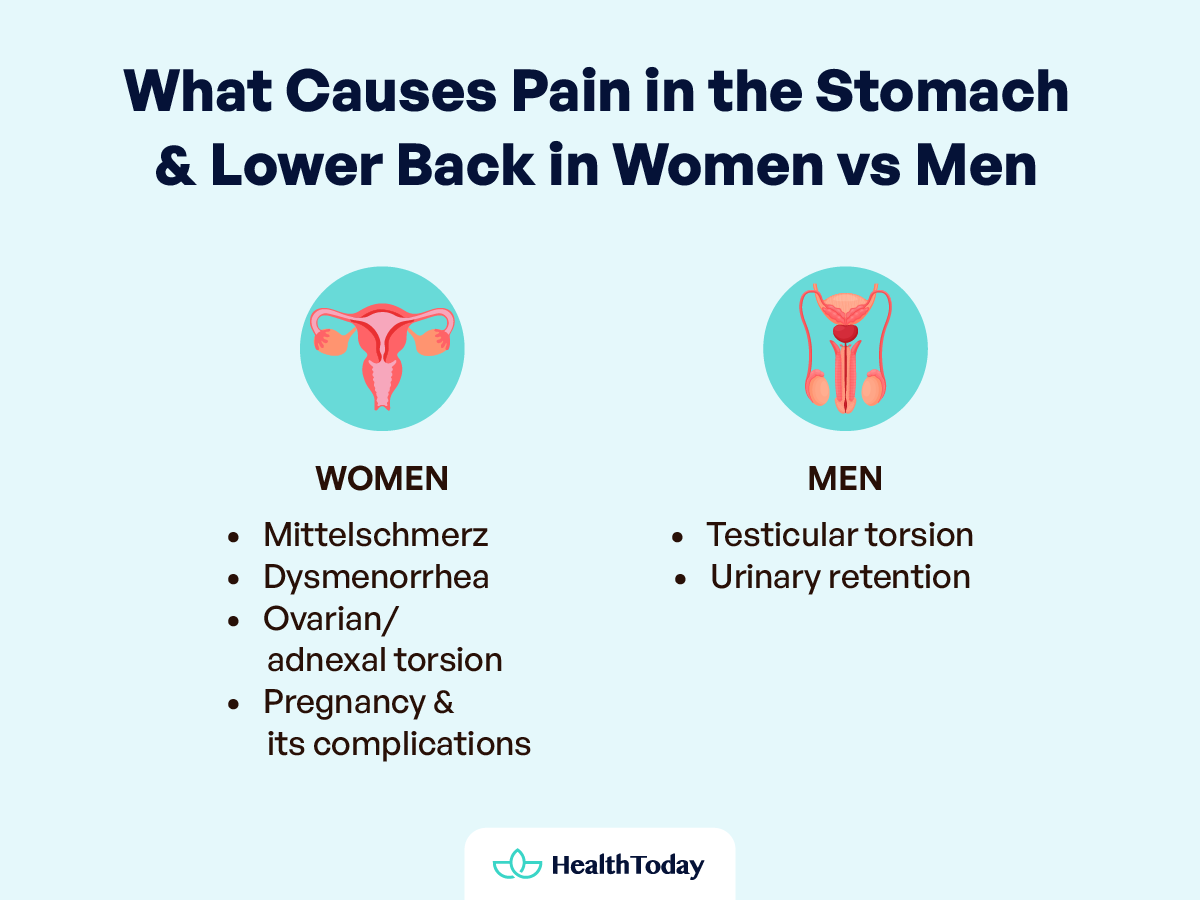

Mittelschmerz
Mittelschmerz is commonly known as ovulation pain.
It typically occurs between days 7 and 24 of the menstrual cycle as a right-sided (usually) lower abdominal pain that may range from mild to intense in severity. The pain usually lasts a couple of hours and may recur each month. An associated back pain may also be present (24).
Dysmenorrhea
Dysmenorrhea refers to painful monthly periods.
The pain occurs in the mid-lower abdomen and may radiate to the thighs or lower back. It usually begins a couple of hours before the onset of menstruation and subsides within 72 hours. The dull or crampy pain varies from mild to severe.
Associated symptoms include gastrointestinal upset such as nausea, vomiting, and diarrhea. Headache, dizziness, and fatigue may also be present.
A painful period may be normal for you. However, any change to your period cycle, i.e., worsening or new symptoms, requires an evaluation from your healthcare professional. A few of the common causes of dysmenorrhea include endometriosis, adenomyosis, fibroids, pelvic inflammatory disease, ovarian cysts, or tumors (25).
- Endometriosis is a condition in which tissue of the uterine lining grows outside of the uterus. Symptoms are cyclical and include pain with bowel movements, urination, and sexual intercourse. Bleeding may also occur with stool, urine, or after intercourse, coinciding with the menstrual periods. Complications include persistent symptoms, infertility, and ovarian cancer (26).
- Adenomyosis is a condition in which the tissue of the uterine lining grows within the uterine muscle and is responsible for heavy menstrual bleeding (27).
- Fibroids are benign tumors of the uterine muscle that typically present with abnormal menstrual bleeding and pressure sensation. Complications include anemia due to heavy periods, pregnancy complications, infertility, constipation, a urinary leak, or urinary tract infection (28).
- Pelvic inflammatory disease is an infection of the female reproductive tract that affects the uterus, fallopian tubes, and/or ovaries. It is often caused by a sexually transmitted infection and causes pain in the stomach and lower back. Pain may occur with intercourse. Vaginal discharge may be whitish, pus-containing, or have a foul odor. Complications include persistent symptoms, ectopic pregnancy, or infertility (29).
- A cyst is a fluid-filled structure. Ovarian cysts may cause right or left-sided lower stomach pain and lower back pain. You might have sharp or dull, intermittent, or constant pain. However, most ovarian cysts are asymptomatic and incidentally found on a physical exam or imaging (30).
- Initial symptoms of ovarian cancer are vague and often lead to a misdiagnosis. Later symptoms include nausea, fullness early after starting a meal, bloating or abdominal distension, change in bowel habits, urinary symptoms, back pain, and painful intercourse. Weight loss and fatigue may also be present. The late disease may present with a pelvic mass or lump, fluid build-up around abdominal organs and/or lungs, enlarged lymph nodes around the umbilicus, bowel or bladder obstruction, skin findings, and worsening of prior symptoms (31).
Ovarian/Adnexal torsion
Ovarian/adnexal torsion is the twisting of the ovary, and possibly the fallopian tube, around supporting ligaments.
It is a surgical emergency as blood flow may be cut off, leading to severe back pain and stomach pain. Pain may also be dull, constant, or intermittent. Associated symptoms include nausea and vomiting. Fever, vaginal discharge, or vaginal bleeding may also be present.
Complications include loss of ovary and infertility.
Ovarian cysts, pregnancy, or fertility treatments increase the risk for ovarian torsion (32).
Pregnancy & its complications
If your pain is accompanied by missed periods, nausea or vomiting, lightheadedness, or vaginal bleeding, consider the possibility that you may be pregnant.
Lower back pain and abdominal cramps are often early indicators of pregnancy. These indicators result from fluctuations in hormones, adjustments in uterine position, and a decrease in abdominal muscle strength. Such discomfort can occur in both typical pregnancies and those complicated by conditions like ectopic pregnancy or miscarriage (33).
Common gynecologic causes that may lead to stomach aches and back pain in females include ovulation pain and painful periods with possible underlying endometriosis, adenomyosis, fibroids, pelvic inflammatory disease, ovarian cysts, or even cancer. Ovarian torsion may also be responsible.
Always consider pregnancy when experiencing abdominal pain.






Treatment of stomach ache and back pain
Keep note of your symptoms and any changes. In case of severe back and stomach pain, consult a physician for an accurate diagnosis and better management.
What is at-home care for stomach pain radiating to the back?
Below are some suggestions for at-home care while awaiting your doctor’s appointment.
- Over-the-counter pain medication:
- Acetaminophen
- NSAIDS, e.g., Aspirin, Ibuprofen (avoid in case of indigestion)
- Over-the-counter antacids or acid reducers for indigestion:
- Antacids, e.g., calcium, aluminum (avoid in case of constipation), or magnesium (Avoid in case of diarrhea) preparations
- Proton pump inhibitors (PPIs), e.g., Omeprazole or Esomeprazole
- H2 blockers, e.g., Cimetidine, Famotidine
- Avoid meals at least three hours before bedtime and sleep with your head elevated in case of reflux.
- Consume a low-fat diet.
- Avoid tobacco and alcohol.
- Apply warm compresses to the abdomen.
- Rest
- Ensure adequate hydration. May add cranberry juice.
- If you have concerns about pregnancy, verify with an at-home pregnancy test kit and refrain from taking unnecessary medications.
When to see a doctor?
Various red flags or worsening symptoms warrant an urgent visit to the emergency room for prompt evaluation and management. Red flags or alarm symptoms associated with each of the conditions described above are listed here.
- Uncontrolled pain or pain not relieved by over-the-counter medication
- Fever
- Ongoing nausea
- Recurrent vomiting
- Blood in vomit
- Blood in stool (often black-colored)
- Abdominal swelling
- Inability to pass stool or gas
- Rapid pulse
- Difficulty breathing
- Lightheadedness






What are the red flags for abdominal pain?
Worsening or new symptoms such as:
-Uncontrolled pain or pain not relieved by over-the-counter medication
-Fever
-Intractable nausea
-Recurrent vomiting
-Blood in vomit
-Blood in stool (often black-colored)
-Abdominal swelling
-Inability to pass stool or gas
-Rapid pulse
-Difficulty breathing
-Lightheadedness
Are stomach and back pain serious?
Yes. While several causes mentioned may not be serious, they may progress to undesirable and even life-threatening complications.
What part of your back hurts with pancreatitis?
Pancreatitis may lead to an upper back pain behind the mid-upper abdomen (epigastrium).
Where is gastritis back pain?
Gastritis may lead to upper back pain.
How do I know if my stomach pain is gastritis?
If you have symptoms consistent with indigestion (dyspepsia) after meals, underlying gastritis may be the cause. Dyspepsia may present as upper abdominal pain, burning, or discomfort; abdominal fullness, bloating, or distension; upper back pain; reflux; heartburn; frequent burping; and nausea or vomiting. An accurate diagnosis, however, will require further evaluation, including an endoscopy.
Summary
The abdomen, the region between the lower ribs and the groin, contains various organs that could contribute to stomach aches and back pain. This article outlines common reasons for such discomfort. It’s essential to seek professional medical attention for accurate diagnosis and treatment, as self-diagnosis or treatment may pose risks due to individual differences in presentation.






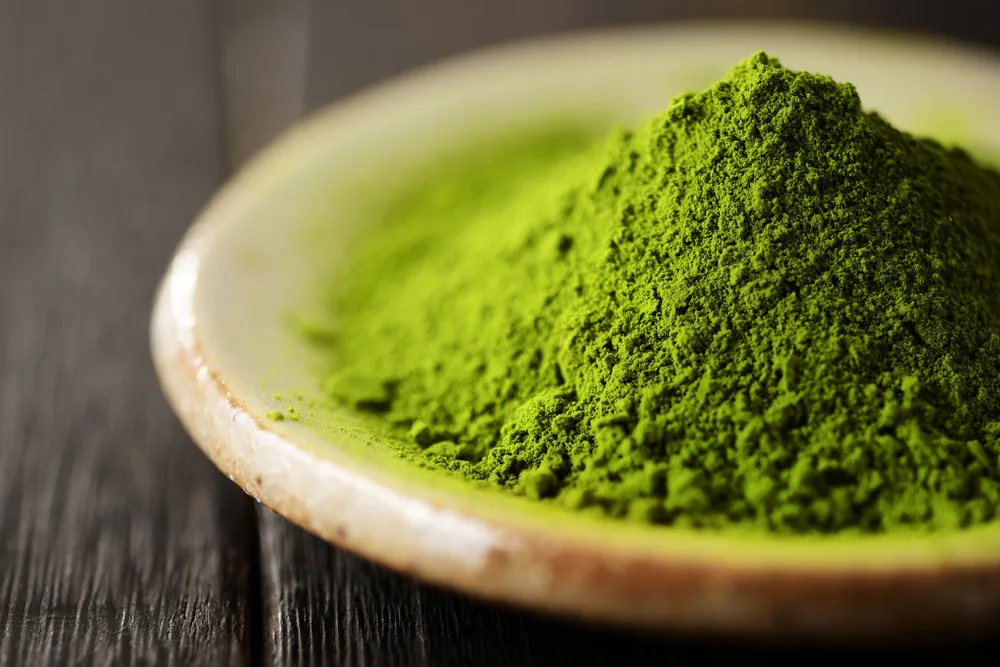

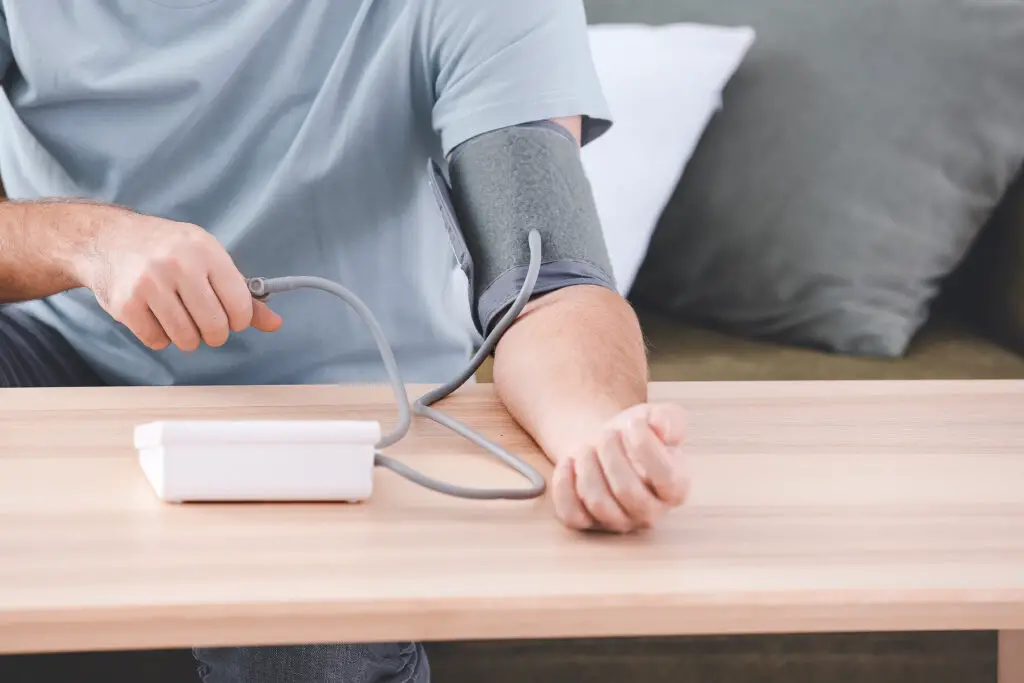

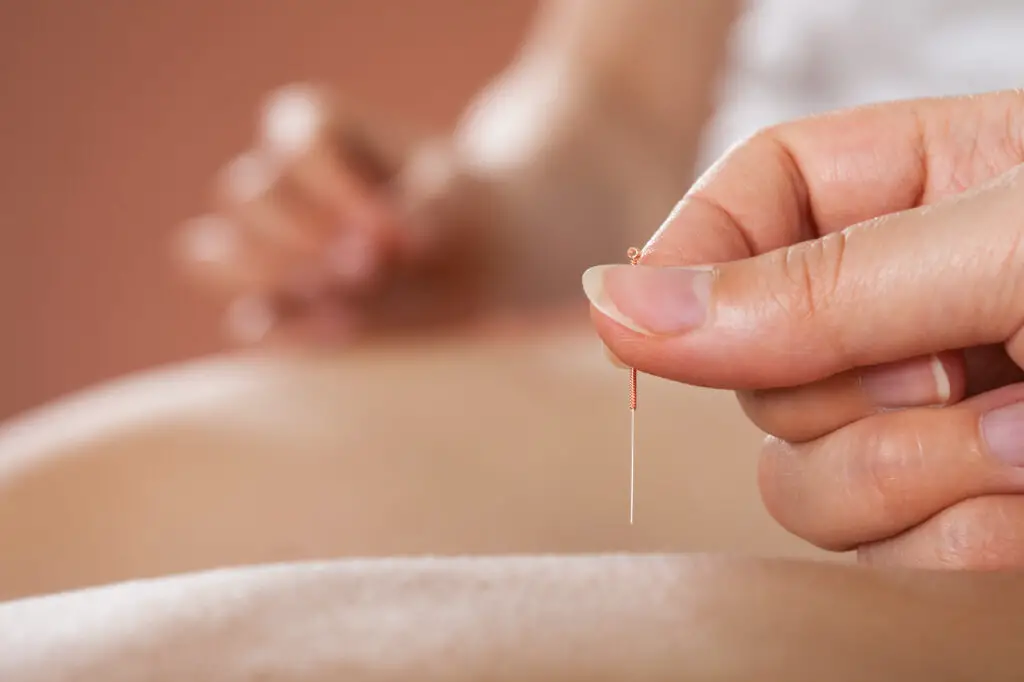

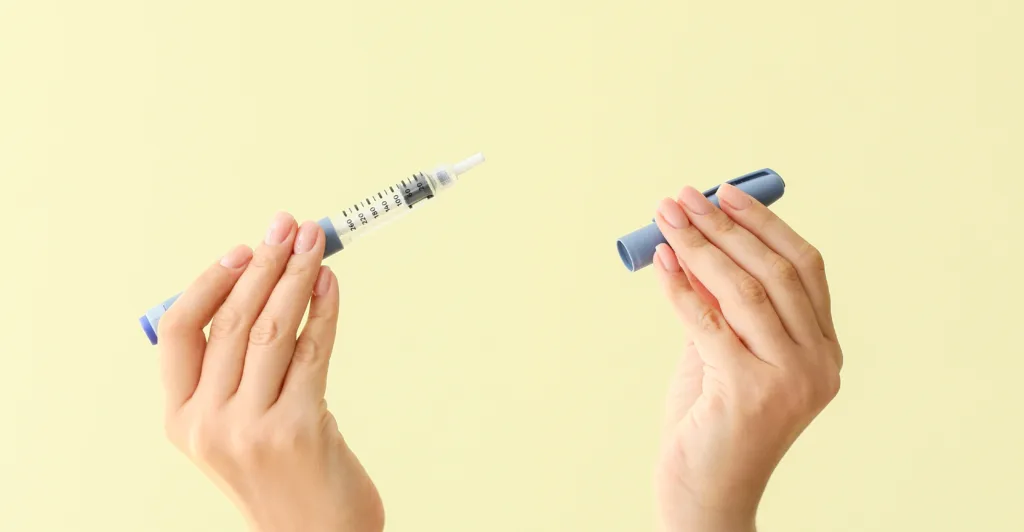


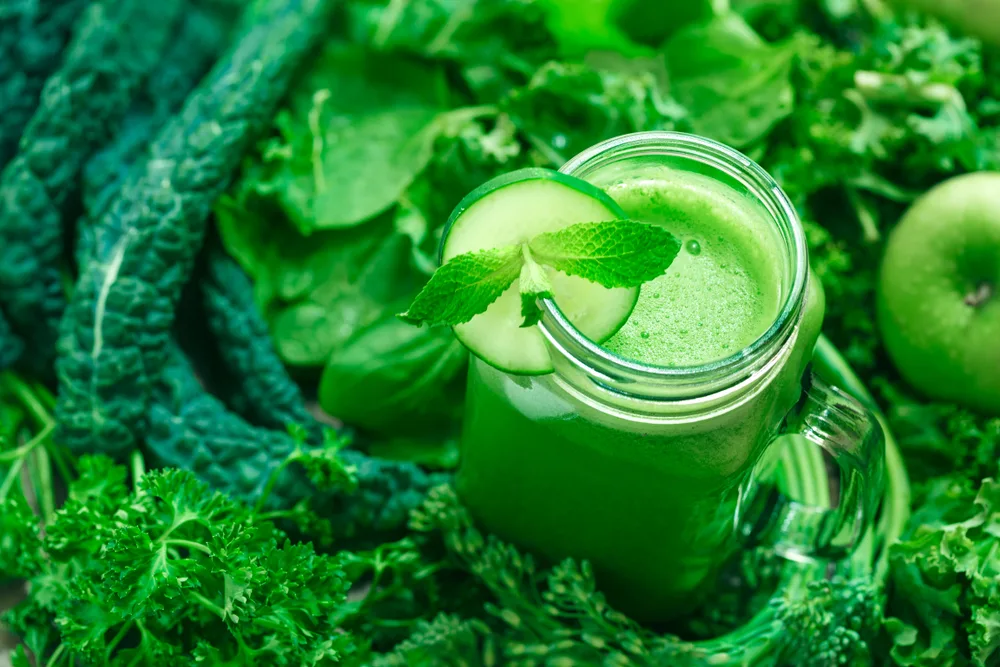

Comments
0